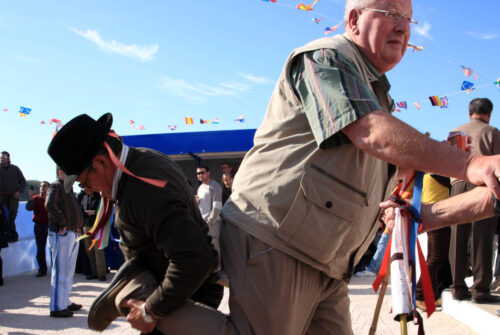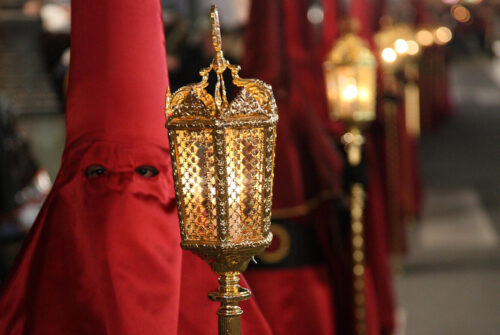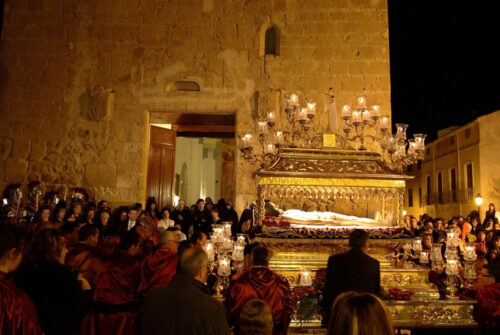Holidays and traditions
- History
- Monuments and sites
- Nature and landscapes
- Gastronomy
- Holidays and traditions
- Active tourism
- Q of quality
- Blue flags
- Weather
An intact tradition ever since time began
In the Mazarrón bay area there are some amazing stories, such as the miracle against Berber pirates or an unusual Easter holiday. These traditions enrich a tight community year by year, with concerts, cinemas and theatre plays, among other events.
Easter holidays in Mazarrón
The first Easter processions in Mazarrón date back to the XVI century. On April 21st, 1579, the Marquis of Velez sent their apologies to the town council regarding the attitude of the general supplier towards the town hall. The letter reads:
‘I want to thank you for all the things that you’ve done for us. Regarding this town villa, measures have been taken to prevent Alonso Merino, general supplier of my Hacienda on Easter Friday in the church, from taken further actions, also in the processions.’
The town council collaborates with the celebrations of Palm Sunday and, from XVII century on, buy palms and bouquets for the aforementioned processions. This is not the only economic support. The council cleans main streets for processions, in accordance to the March 1767 decree.
Brotherhoods of Mazarrón in both XVII and XVIII centuries gather around several temples. The oldest one is Nuestro Padre Jesús Nazareno, founded in 1653-1655 and regulated again in 1876.
In mid XIX century, brotherhoods in Mazarrón are reorganized, hence the regulations kept in some brotherhood headquarters such as Verónica, San Juan, Nuestro Padre Jesús, and some others. These brotherhoods remained active until the Spanish Civil War, when images were destroyed. Once the war was over, some families decided to make processions again, with little to no means.
In the 50’s, with a dozen carnations, lilies, thyme and rosemary bouquets from the forest, streets were perfumed for the Calvary procession statues, with a wooden cross shown next to the statues of Nuestro Padre Jesús, Santo Sepulcro, Nuestra Señora de la Soledad y San Juan.
Back to 1981, due to the lack of interest in Easter processions, some neighbours decide to revitalize them.
A single brotherhood is born: the Cofradía del Santo Cáliz de la Preciosísima Sangre de Cristo, with the statutes passed on February 6th, 1989 and comprised of four other groups, later on four brotherhoods, the only ones present in Mazarrón Easter: Nuestra Señora de la Soledad, Nuestro Padre Jesús, San Juan and Santo Sepulcro. Later on, every brotherhood will have their own statues, then dissapearing the original brotherhood containing all four.
Easter processions in Mazarrón take place on Holy Wednesdays, Thursdays and Fridays.
On Holy Wednesday, the procession of the Promesas takes place. It dates back to 2008, and both Nuestra Señora de la Soledad and Cristo de la Soledad brotherhoods take part, the latter accompanied by a regiment of Roman soldiers.
Easter holidays in Puerto de Mazarrón
In the 90’s, a small group of elderly people, driven by Christian Faith, decided to create a brotherhood to revere some images of the Virgin, and even creating a procession for the Puerto de Mazarrón.
In 1994, these people bought a small image of the Virgen de las Penas, a statue from Málaga that belongs to San Julián Church, in the same city.
Once the image was located in Mazarrón, permission had to be asked to the brotherhood of San Pedro, already existing in the Puerto, to participate in Easter processions.
The aforementioned group (around 20 people) from the elderly home in Puerto de Mazarrón, asked the manager, José Segura Obrero, to locate there. The permission was granted to promoters, such as Ms. Ángeles Martín Vigara, Ms. Magdalena Herranz and Mr. Pedro Chico, appointed as president.
Next, a small throne is built for Saturnino Agüera, to procession the original Nuestra Señora de las Penas, just as in Malaga. The throne could be carried by 8 costaleros (carriers) that bought their own clothes, initially black ones. These costaleros were under the supervision of Francisco Caballero, who is the current foreman of this procession.
In 1996, with the approval of the Bishop of Cartagena, Javier Azagra Labiano, and the priest from San José, in the Puerto de Mazarrón, and the vicar of the region, the brotherhood of Nuestra Señora de las Penas is established, generating the statutes based on faith towards Catholic church and the images of the Virgin, with members of the Board of Government Mr. José Moreno Marín, as President, and Ms. Mª Ángeles Martín Vigara, as Secretary, plus a group of administrators and costaleros.
In 1997 there is a change in the Board of Directors, with Fernando González Cano as President and Juan Navarro Molina as vicepresident, plus a group of religious administrators, costaleros and penitents that had the idea of displaying a new image of the Virgin, with a superior height and hence with a new throne, suitable for the new dimensions.
In 2002 a new image was finally bought. It was blessed by parish Roberto Burgos Azor that very same year. Today, the sculpture marches under a recently bought canopy, and the brotherhood has 150 members and more than 300 sympathizers.
On October 19, 2009, new statutes were approved (the older ones were now obsolete), being the former the final ones. On January 14th, 2010, a new Board of Directors was elected.
Romería del Milagro
From XVI to XVII centuries, life in Mazarrón was closely related to dangers from invasions stemming from the North of Africa.
According to Council Chapter records, Berber pirates disembarked almost on daily basis, robbing, stealing and threatening the inhabitants of the council of Almazarrón.
The insufficient line of defense consisted of some postings, a castle without any weapons and reports (not always on time) from Cartagena and the Jurisdiction of Murcia.
In this historical context, the ‘Milagro of Almazarrón’ occurred, and social and consequences that stemmed from it could be seen later on.
According to the ‘New Declarations of the Miracle’, written by the council scribe according to some witnesses, in the early hours of November 17th, 1585, fifty pirates that docked their ships in Bolnuevo tried to enter Mazarrón to loot the Council.
Their unexpected flee add fuel to the legend of the Miracle, nourished by the reports from the monk Ginés García Alcaraz, that described all events that took place after the disembark in a book published later on by the Franciscan Order of Mazarrón:
‘When pirates started to run away, a beautiful maiden appeared and forced them to disperse without hesitation. Pirates were so terrified that they seemed to see a vestige on every corner and a giant on every pinnacle, threatening either with slavery or death.’
According to theose reports, most of the inhabitants were asleep in the wee hours of morning, but were startled by the alarm of the bell of the church of Concepción, that sounded without any human intervention.
Once the pirates were gone, the inhabitants entered the church to give thanks to God and saw the image of the Virgin looking at the sea, with her mantle wet and scattered sand from the sea. They also noticed that the lamp, which had no light from the previous day, now was lit and pouring oil in abundance.
That’s the report that García Alcaraz wrote based on oral traditions and the file that the town council ordered to be written.
It is evident that the details of this ephemeris were passed down through families since the event took place in a church where an image of the Immaculate was set since time immemorial.
The events of November 17th made inhabitants understand that the Purísima safeguarded them day and night, and that’s why they immediately appointed her as their benefactor.
Mazarrón was the first council in Spain to take the Inmaculada Concepción as their patron saint. In 1761, the whole Spain also appointed it. December, 8th is now a national holiday in the country. Among several places with a marked devotion, Santa Cruz de Tenerife and La Linea de la Concepción are ranked among the first, and hence there are sanctuaries honoring her.
It is also revered in Yecla, Fortuna and El Palmar, all of them located in Murcia. In the early XVIII century, a new chapel was built in the place of the old sanctuary, with the additional foundation of a Franciscan Order that contributed to the cult and the ornament activities. From that point on, all the inhabitants of Mazarrón, especially fishermen, have an unconditional love for the Inmaculada Concepción.
Those fishermen throw their nets to the sea in her name; farmers made an appeal to her in their first plantings; the ills expected to be cured thanks to her; the absentees want to go back to their roots to visit their chapel and, when holiday comes, the heart of inhabitants of Mazarrón race due to her presence.
A few centuries later, in 1941, a priest under the name of Jesús García arrived in Mazarrón, and set up the construction of a sanctuary in the same place where the ruins of the Los Caballos tower were located, close to the coast and the Bolnuevo country house.
Mr. Jesús (as he was known by the parishioners), created a weekly religious magazine that was precisely called ‘Sanctuary’. OnFebruary 24th, 1946 he wrote:
‘During VI century, this tower served as a bastion and a surveillance tower TO Moorish attacks. During one of those attacks, the Purísima Concepción worked her famous miracle (…) The Holy Virgin arrived to the beach of el Castellar, chasing away with her presence the Moorish pirates that pretended to inflict fear on the peaceful neighbors of this town. Sea daffodils still grow on these beaches. They are mysterious flowers that can only flourish there, unable to adapt to other places. Don’t you think that it would be reasonable and just to erect a chapel or sanctuary devoted to the Purísima right there, were this miracle took place?’
The first stone of this fortress-sanctuary was placed on November 17th, 1947 (the Day of the Miracle) and, the following year, the Pilgrimage of the Miracle (“Romería del Milagro”) started. The pilgrimage happens every year, on Sunday after November 17th, with the pilgrims carrying the statue of the Virgin from her sanctuary in Mazarrón, to the chapel in Bolnuevo by the beach, which is 5 km away.
This is the curious way chosen to remember the Virgin’s journey when she left her chapel to chase away the Saracens. Besides, the miracle is also celebrated with a Solemn Mass and a Patron Saint procession, paying a visit to the churches of San Andrés Apóstol and San Antonio de Pádua.
‘The Romería del Milagro is a symbolic and festive act that has achieved such a relevance in the local festivities to the point that it can be considered the most participative event in town, not only because of its attendance from the neighbors but because of the massive arrival of visitors from nearby towns, that have made this pilgrimage their own.
The view of thousands of pilgrims spending the day by the beach in the coast of Bolnuevo, is astonishing. By the sand, next to the improvised stakes used to grill sardines and other culinary delicacies, in camping tents… it is a day to meet your neighbors and fraternize, and any place is good to do so.
However, the most relevant aspect of this story is perhaps the acknowledgment that this tradition has endured unchanged, therefore becoming one of the few identity features that define us as inhabitantes of Mazarrón. Our most ancient past, shaped in a titanic fight for survival in a hostile territory, followed the economic highs and lows of the alum production, lead mines and even the agriculture setbacks in modern times.
Almazarrón, a welcoming land and a place for encounters, has known how to keep in its memory one of the most beautiful chapters that has been written around its own origin’.
Besides this festival, neighbors of the different boroughs and suburbs that compose the municipality of Mazarrón also celebrate their own local festivities, enjoyed and attended by the very own neighbours and also visitors. Festivities of San José, San Isidro o El Carmen in Puerto de Mazarrón, Rebuzno in Balsicas, or San Antonio in Cañada de Gallego are among the most remarkable ones.
Besides these festivities, the carnival is also widely celebrated, with passacaglia music and parades. Traditionally celebrated in February, in Mazarrón also takes place during the summer.



